Train Proper Straight Edge Use for Bonus Quality Paving
BY John Ball
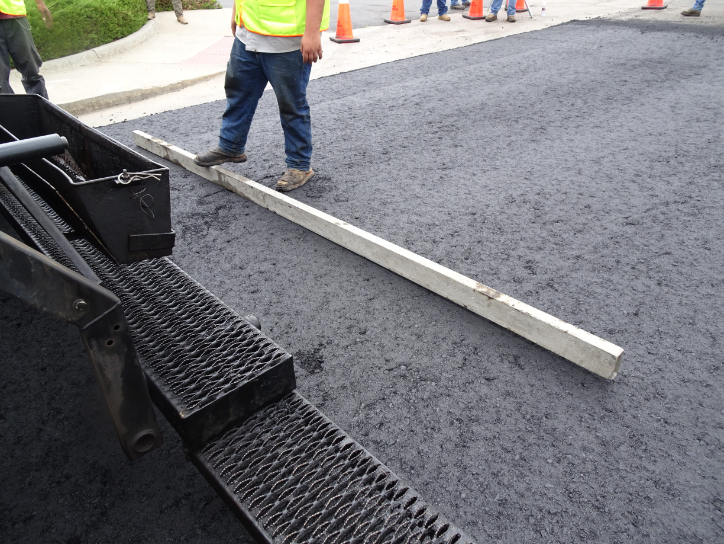
This article will talk about the proper use of the metal straight edge for good quality control during paving, but we have some extra tips to point out along the way. Let’s start with the reason for having a straight edge out on the paving job.
The untrained or new laborer might not understand why the crew has an 8-foot-long, 11- or 14-gauge, 2 by 4 steel tube on the deck of the paver or in the back of the work truck. This vital tool will help all the laborers—from the new guy with the rake to the foreman trying to figure yield. It helps you keep track of slope, high and low spots, crown, and proper takeoff depth in the mat. You’ll use the straight edge to check joints, match height and any number of quality control/quality assurance (QC/QA) factors that affect your pay.
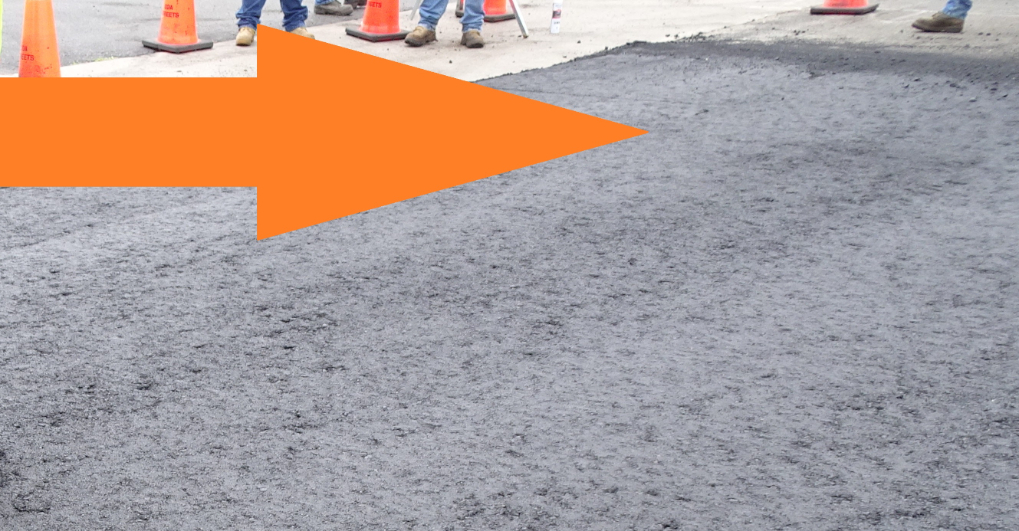
The orange arrow points to the area where beginning-of-load segregation showed up in this binder course. You can minimize this if you avoid running the hopper empty between trucks.
Before you even begin the paving day, here are some steps we need to do first.
- Step #1 null out tow point cylinders while the screed is on the ground.
- Step #2 with another worker, null out the depth cranks on each side of the screed.
- Step #3 on each side of the paver, make the endgates level with the screed.
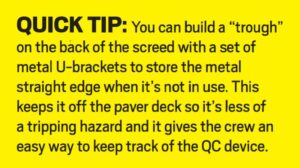 With those steps done, you’ll raise the screed and place the straight edge against its underside to double-check the smoothness of the screed plate. For this quality check, make sure the slope extensions are not engaged.
With those steps done, you’ll raise the screed and place the straight edge against its underside to double-check the smoothness of the screed plate. For this quality check, make sure the slope extensions are not engaged.
You’ll place the straight edge against the trailing edge of the screed for this check. A sixteenth of an inch of crown in the screed is acceptable/normal. Anything more than that is a problem. These back-to-basics steps are spelled out in detail in the online training course.
Back in the old days, when screed plates were 36 inches wide, we had the lead crown and tail crown to consider. Don’t worry about multiple readings now that the typical screed plate is only 18 inches.
Once you’re ready to pave, you may be starting the project with a takeoff pad. You can read the article “Get Basics Right for Top Quality Overall” on TheAsphaltPro.com about how to build one of those in a parking lot scenario.
As the paver operator paves forward, one of the laborers needs to place the straight edge on the mat to check the fluff factor. He will place the straight edge parallel to the longitudinal joint, behind the left side of the screed first. This initial 8- or 12-foot section will let you see if there’s a dip or a bump in the mat where the screed may have settled when you took off. If you see a dip or bump, you know to adjust your angle of attack.
Read the article “Check the Angle of Attack” on TheAsphaltPro.com for a primer on that.
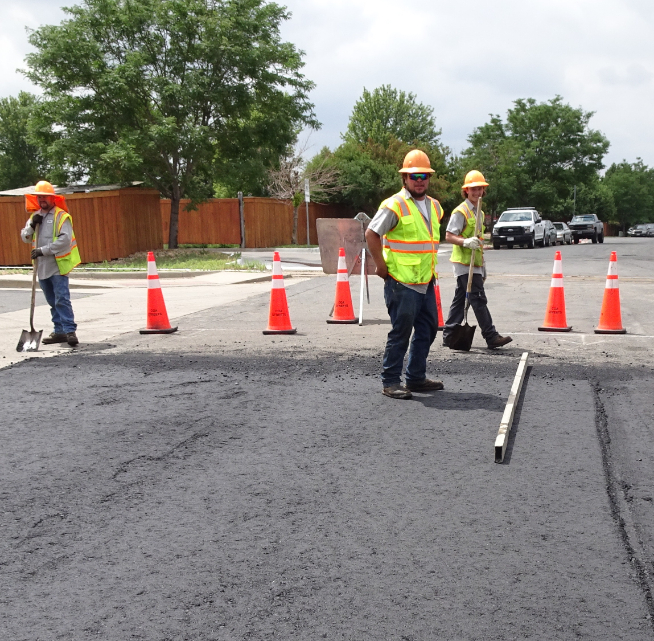
When you place the straight edge parallel to the long joint, you can see where any dips or rises in the mat might affect the smoothness of the ride down the travel lane.
After checking this section of the mat for quality, the laborer will move the straight edge to parallel to the longitudinal joint, but behind the right screed plate. You want to check both sides of the mat because both depth cranks are controlled independently; if one has more height in it than the other, you could have different results happening on the right and left sides of the mat.
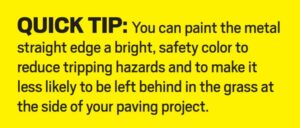 Another element to watch out for when taking off is the beginning-of-load segregation seen in the picture in this article. The area of segregation occurred because the crew ran out of mix in the hopper when they sat down. They moved the material to the auger while the paver was stationary. You can end up with a full auger section, but an empty hopper, if you run the augers while the paver is sitting and waiting for trucks. When the next truck arrives and charges the hopper, you introduce new, hot mix to the system. The material at the auger chamber is one temperature and one consistency. It’s not homogenized with the new material coming in. You’re introducing beginning-of-load segregation, which will show up in the mat.
Another element to watch out for when taking off is the beginning-of-load segregation seen in the picture in this article. The area of segregation occurred because the crew ran out of mix in the hopper when they sat down. They moved the material to the auger while the paver was stationary. You can end up with a full auger section, but an empty hopper, if you run the augers while the paver is sitting and waiting for trucks. When the next truck arrives and charges the hopper, you introduce new, hot mix to the system. The material at the auger chamber is one temperature and one consistency. It’s not homogenized with the new material coming in. You’re introducing beginning-of-load segregation, which will show up in the mat.
Avoid beginning-of-load segregation by waiting for the truck to back into position and to charge the hopper as you simultaneously move material with the feed conveyors to the auger chamber.
Depending on the type of project, you may want a crown in the mat or a hint of slope to drain toward the shoulder or so on. In the picture, the straight edge shows that the crew has about a quarter-inch of crown in the mat. This means there’s slope in the extension. This crew is paving the first 15-foot-wide binder course pass of a 30-foot road.
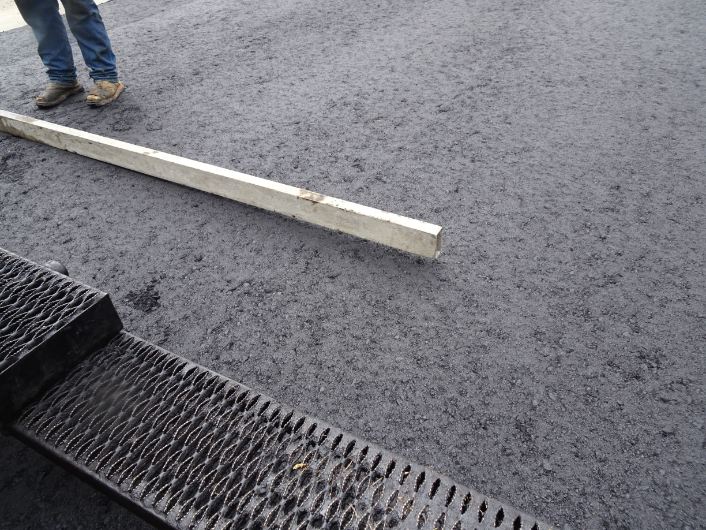
A closer look at the end of the straight edge shows how far it is off the mat. Use a ruler to measure this distance and double-check your slope settings. Here we can see that we have about half an inch of discrepancy. If we didn’t want the crown in the mat, we would need to adjust the match height down the quarter inch on that side, bringing the extension level with the main screed plate.
When we look more closely at the space under the straight edge, we can see that we have about half an inch of discrepancy. If we didn’t want the crown in the mat, we would need to adjust the match height down the quarter inch on that side, bringing the extension level with the main screed plate. By balancing the screed all the way across, we would remove the slope. We double-check our success with the metal straight edge.
If you receive the Monday morning toolbox tips from AsphaltPro, then you know about having a wooden 2 by 4 on the paving project for supporting the uncompacted edge and other best practices. For QC/QA checks, you want your straight edge to be steel, not wood or string between a couple stakes. The metal straight edge is less likely to warp from moisture and heat than a lumber 2 by 4; it also won’t stretch the way string will. That means the metal straight edge will stay useful for checking quality.
Sign up for the Monday morning toolbox tip email here.
John Ball is the proprietor of Top Quality Paving & Training, Manchester, New Hampshire. He provides personal, on-site paving consulting services around the United States and into Canada. For more information, contact him at (603) 493-1458 or tqpaving@yahoo.com.
